
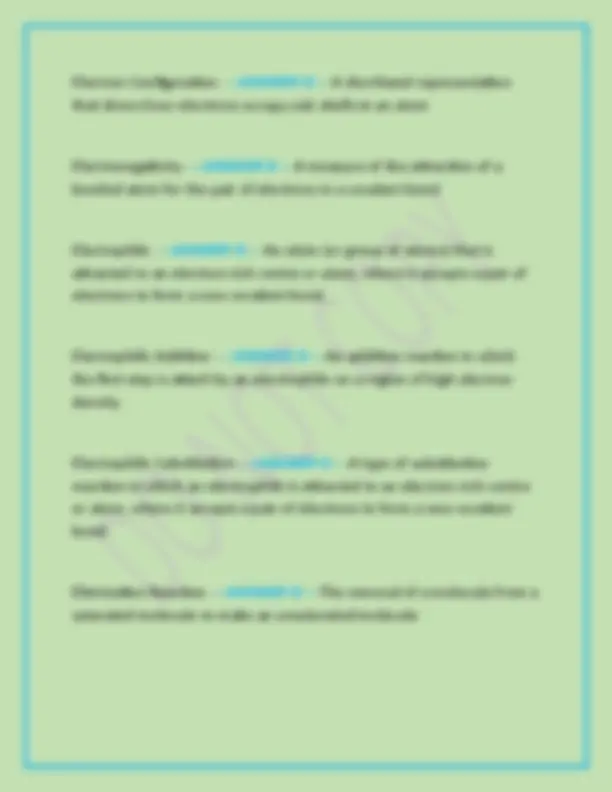
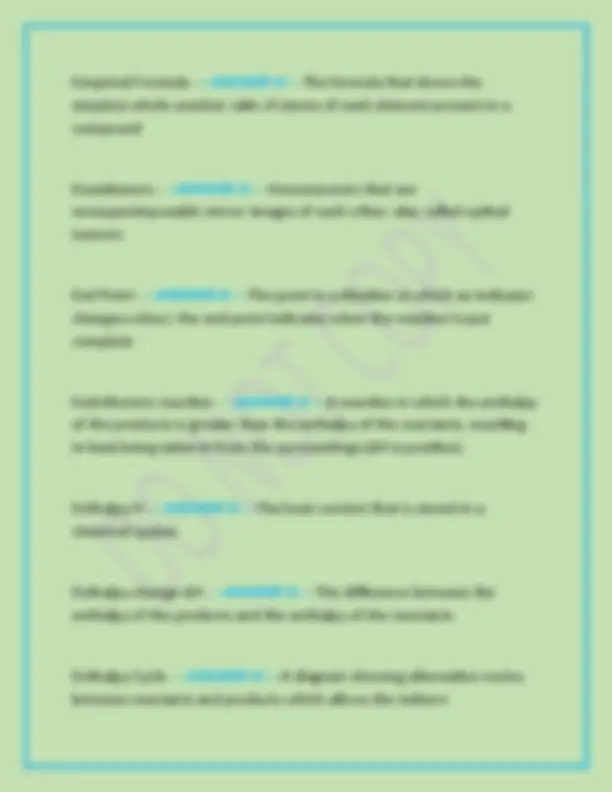
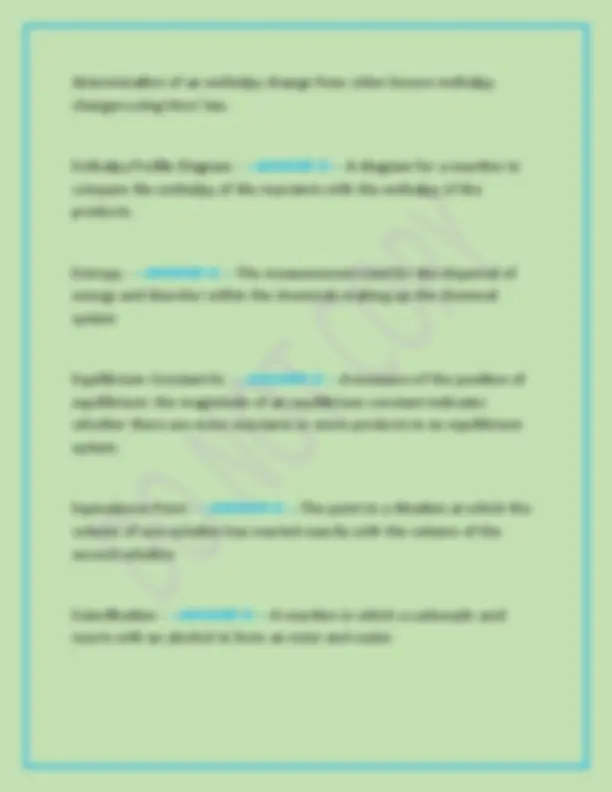


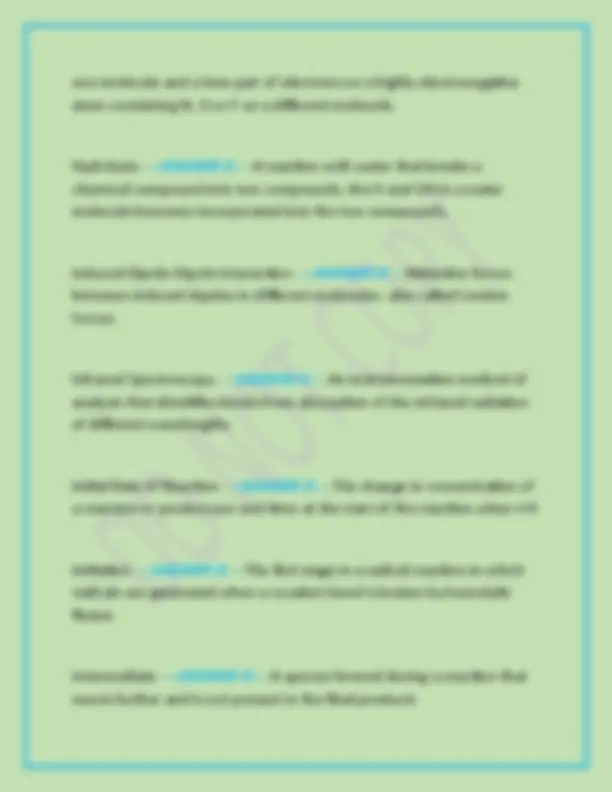
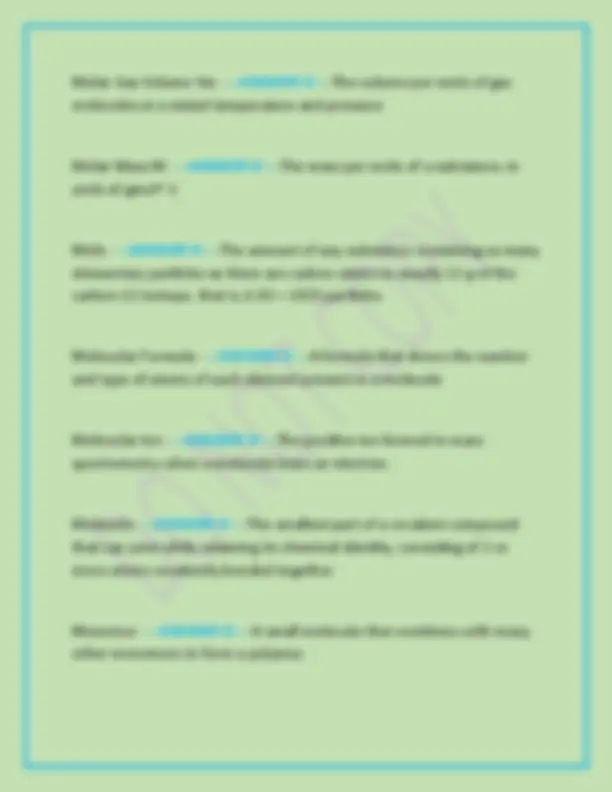
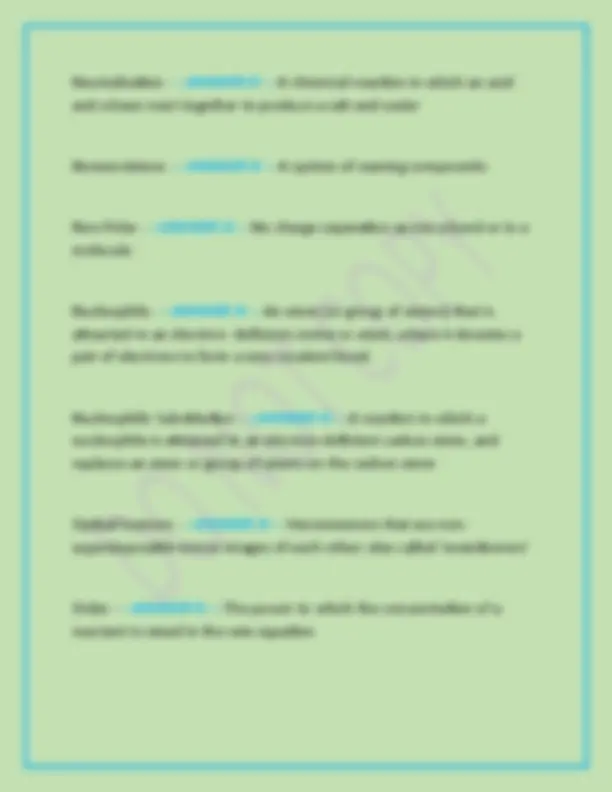
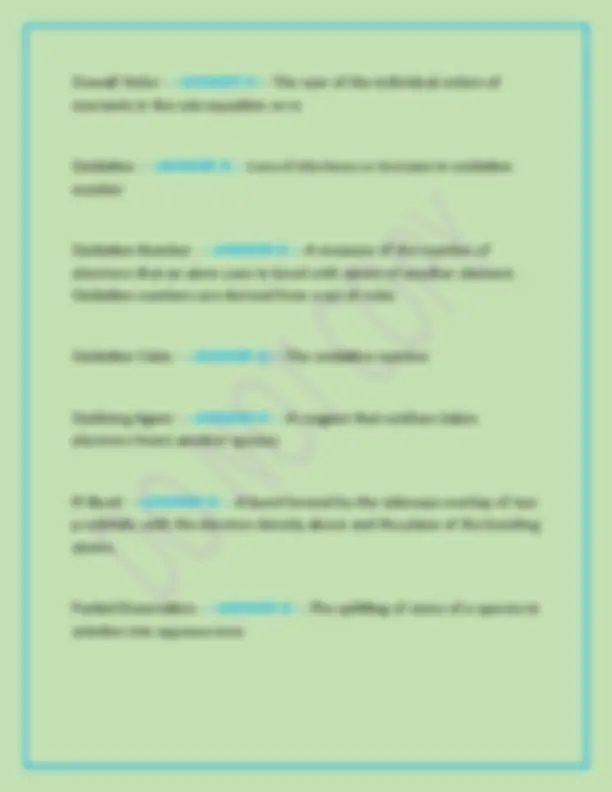
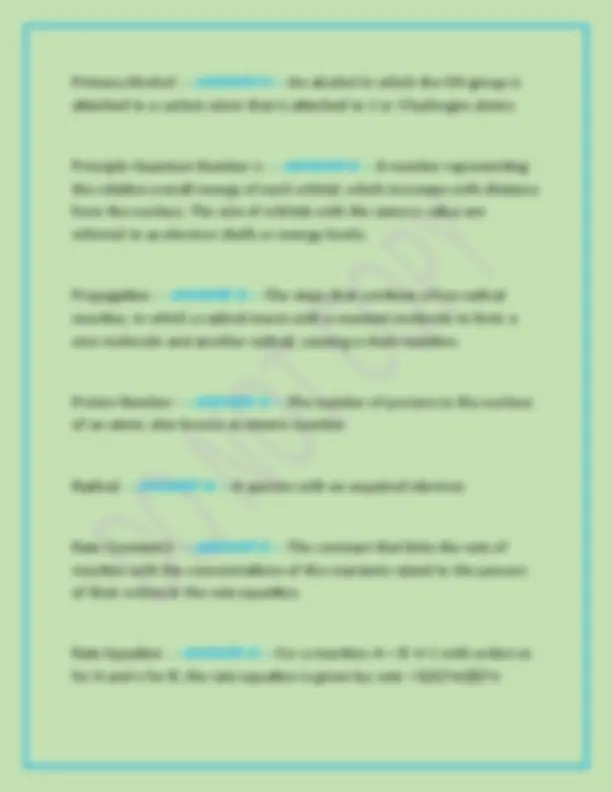

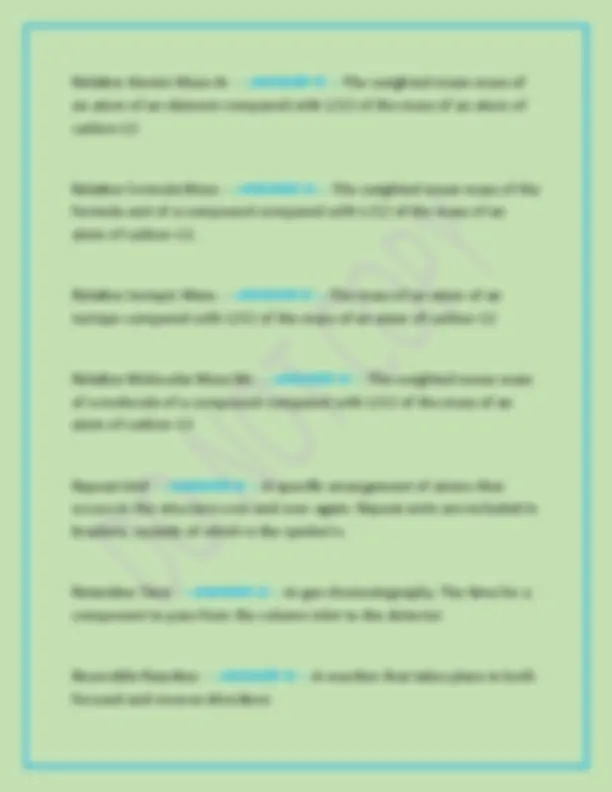


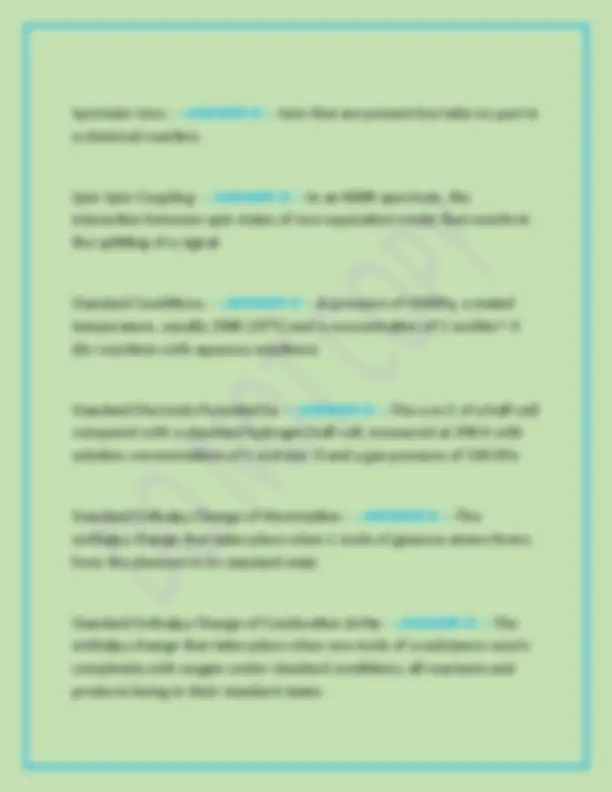


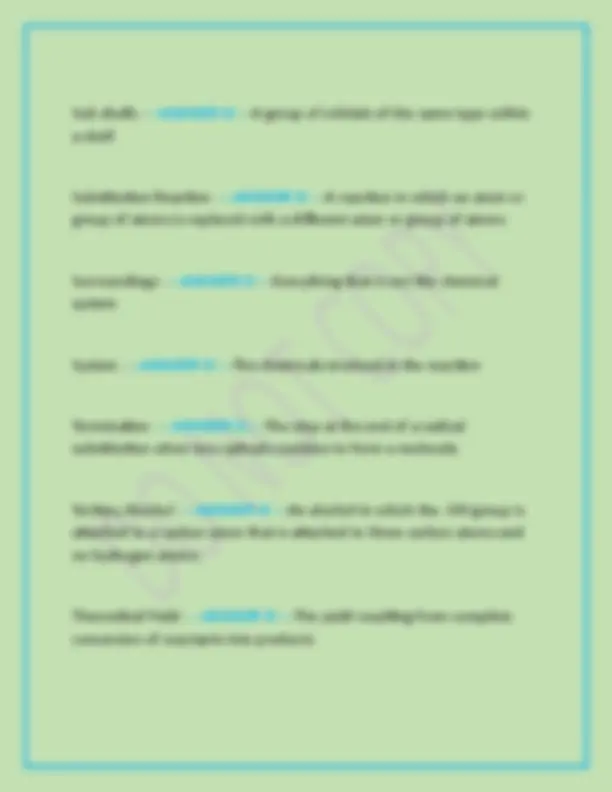
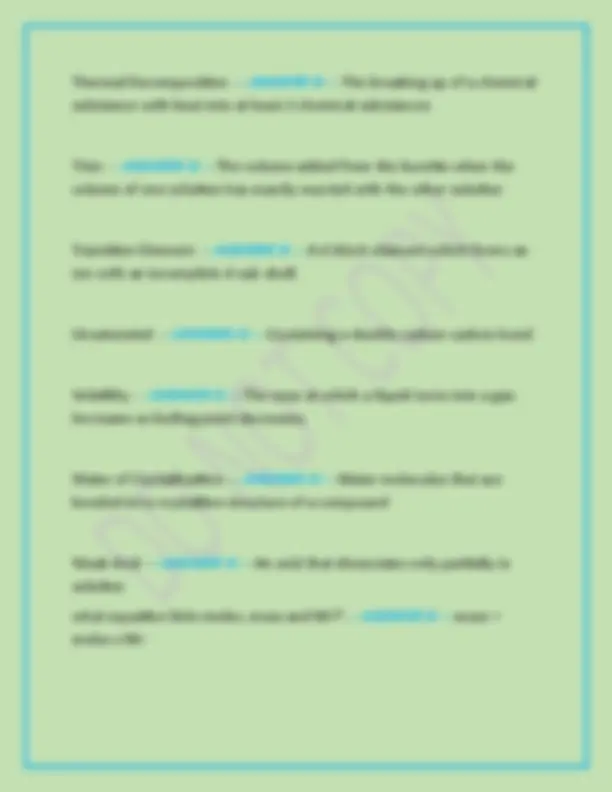
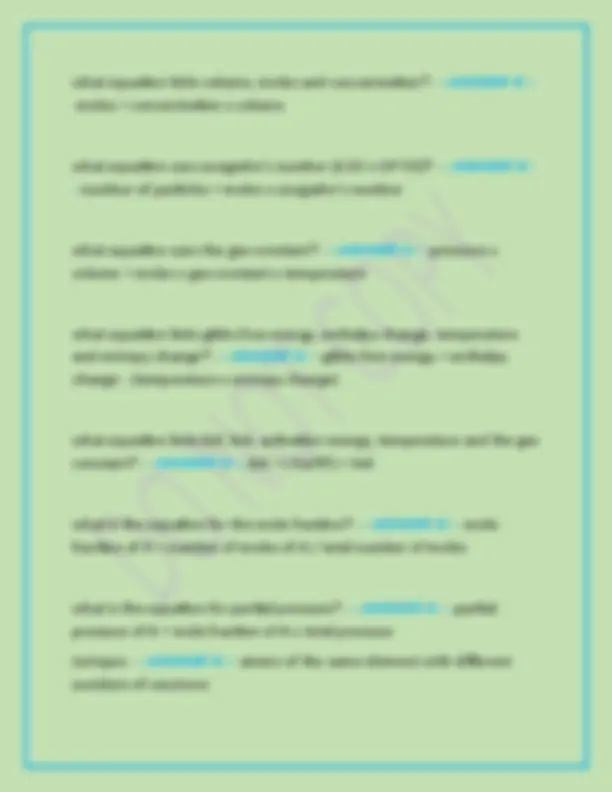
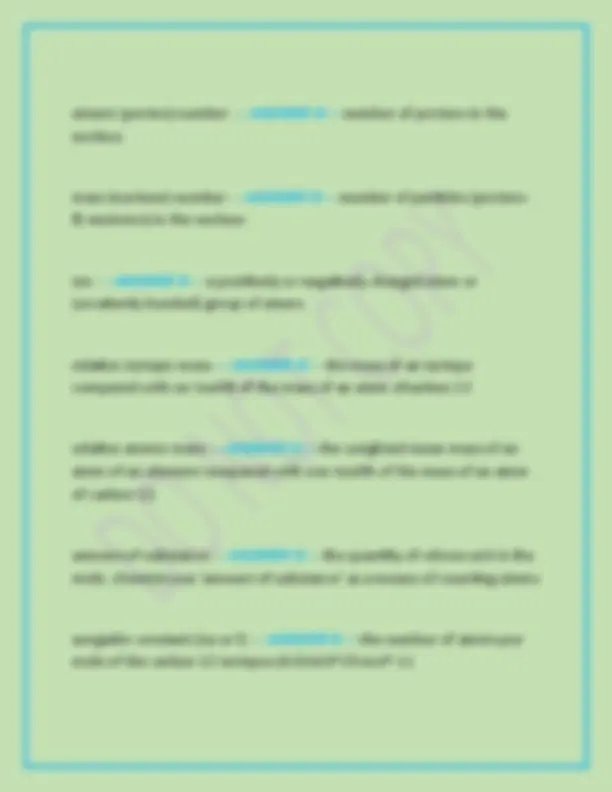
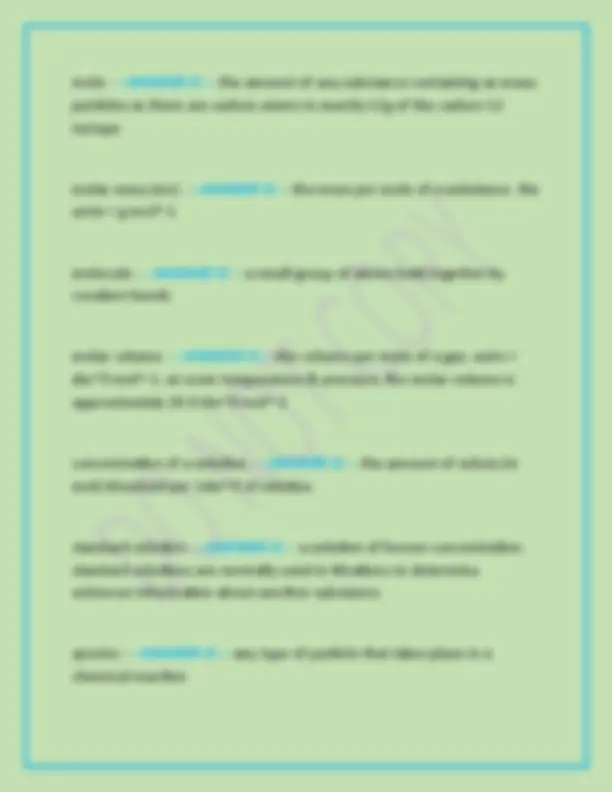
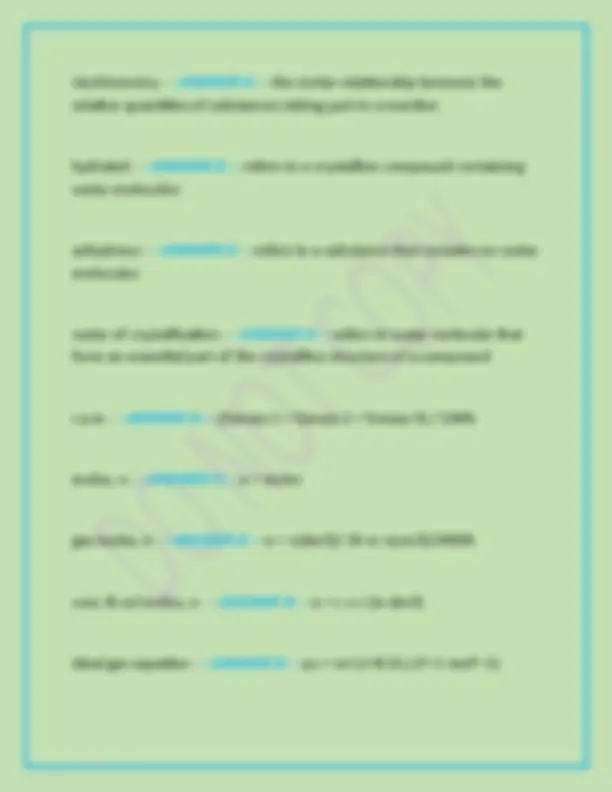

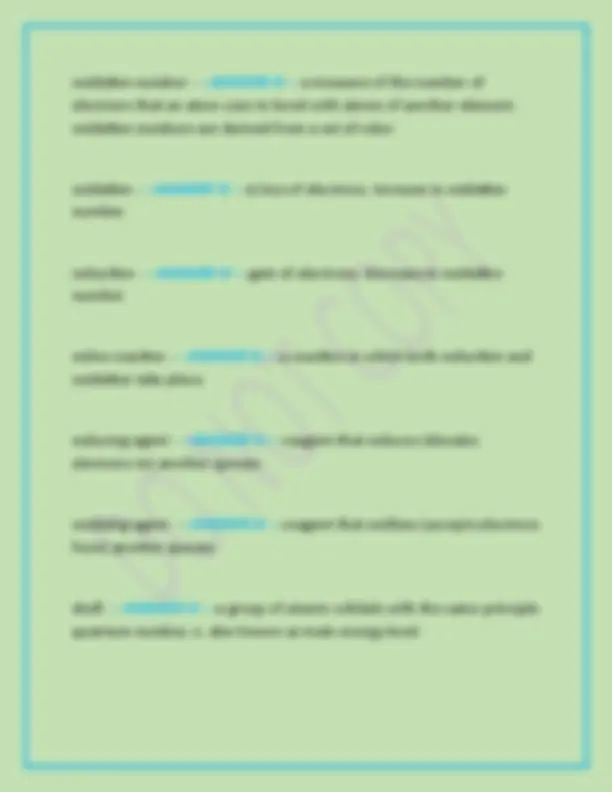
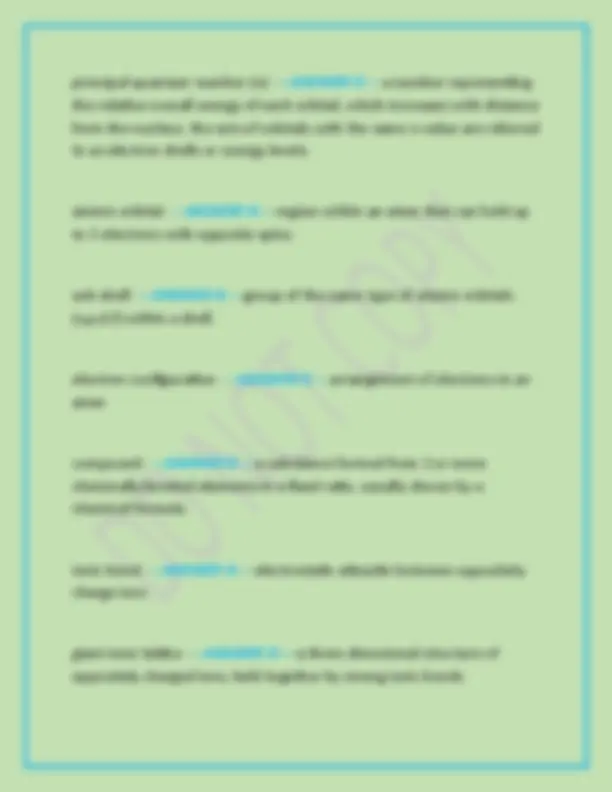
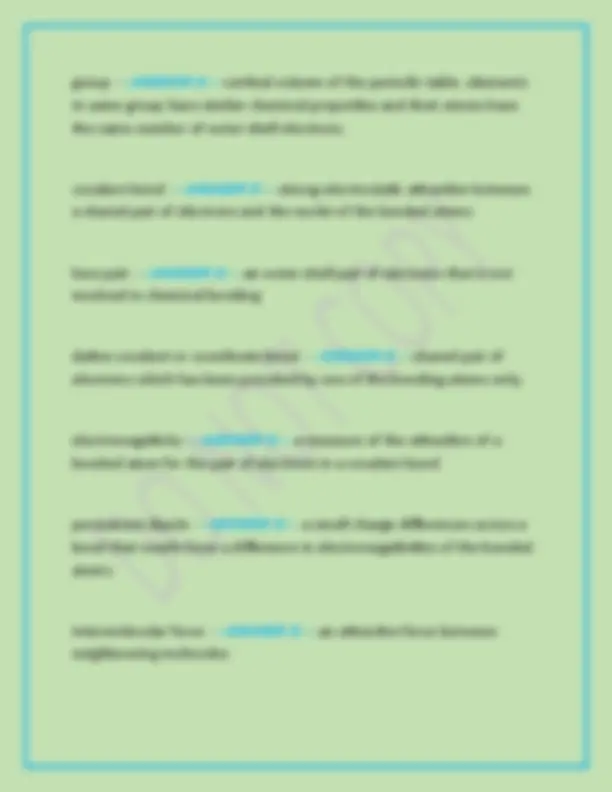


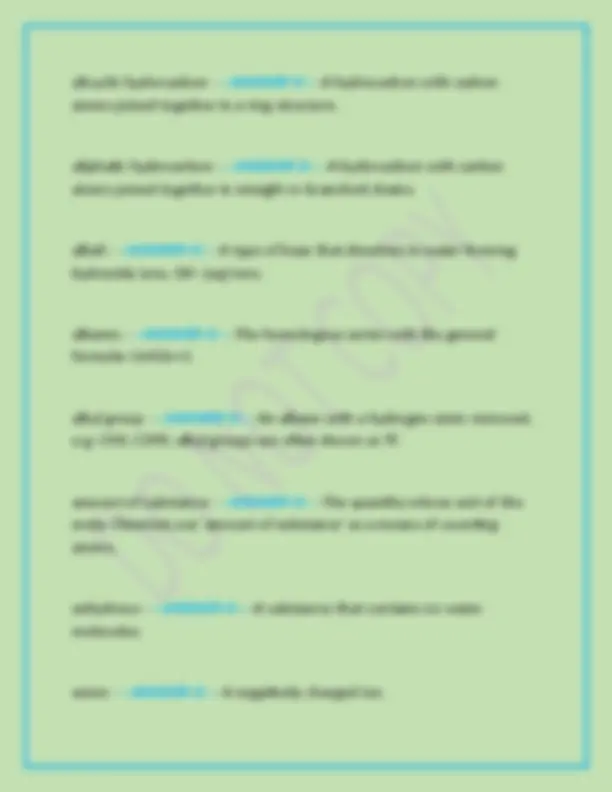
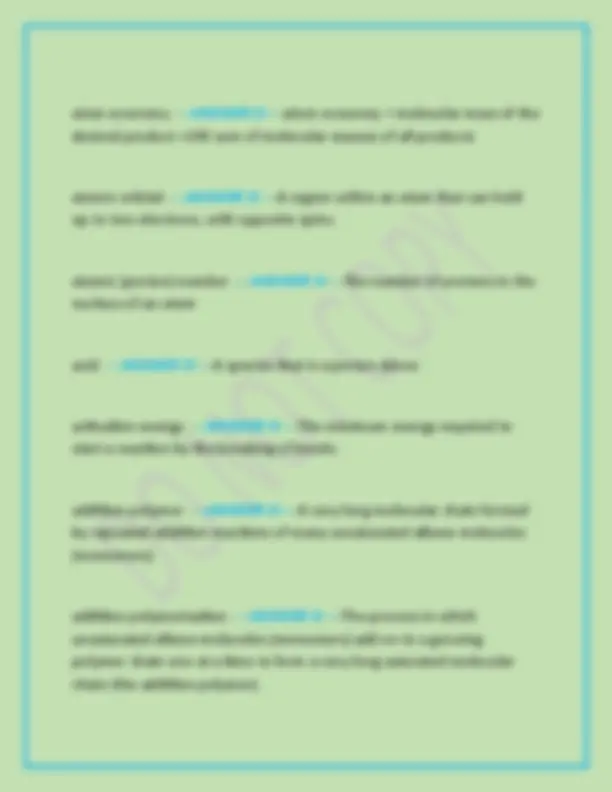
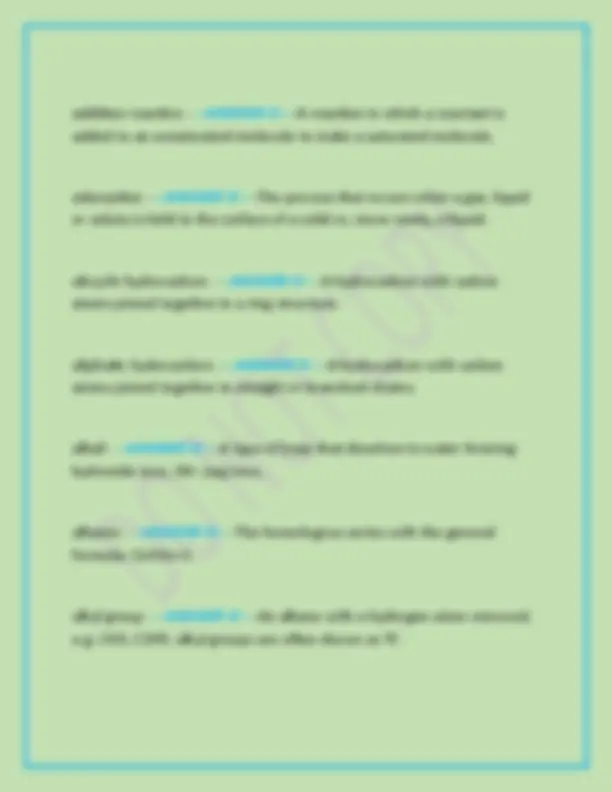
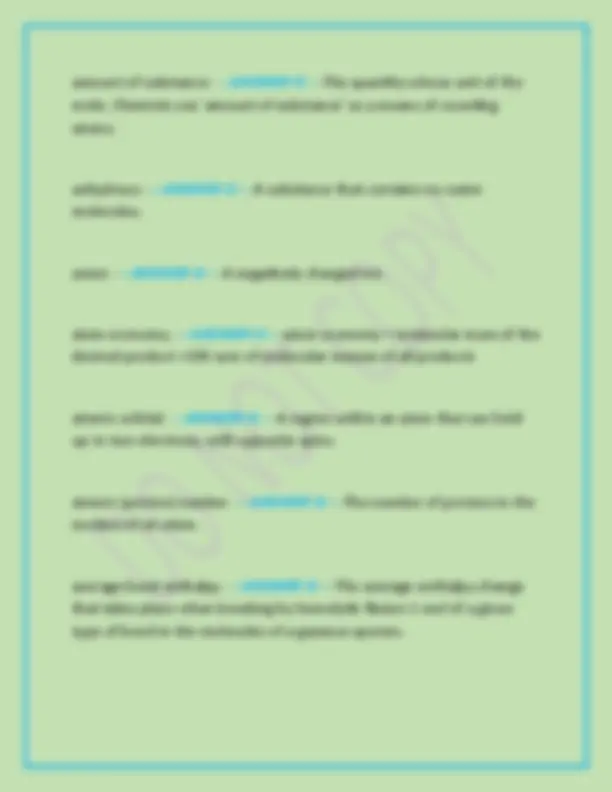
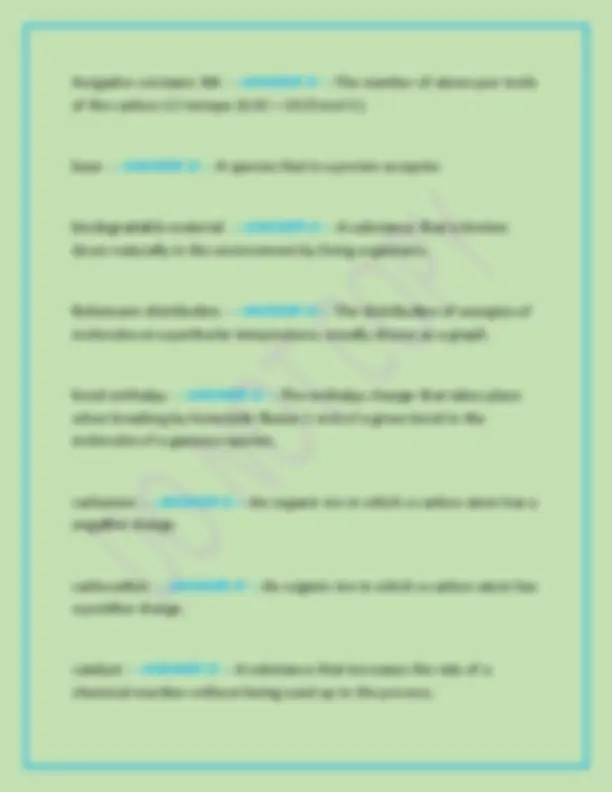
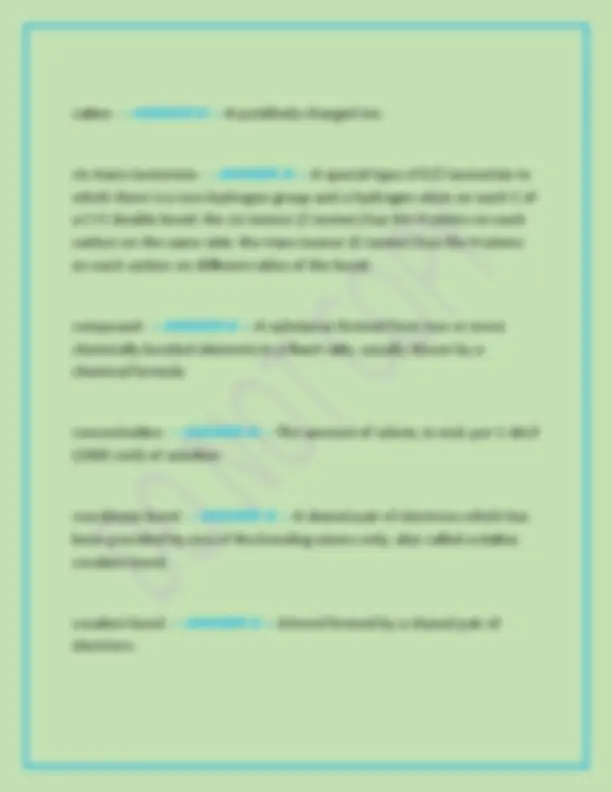
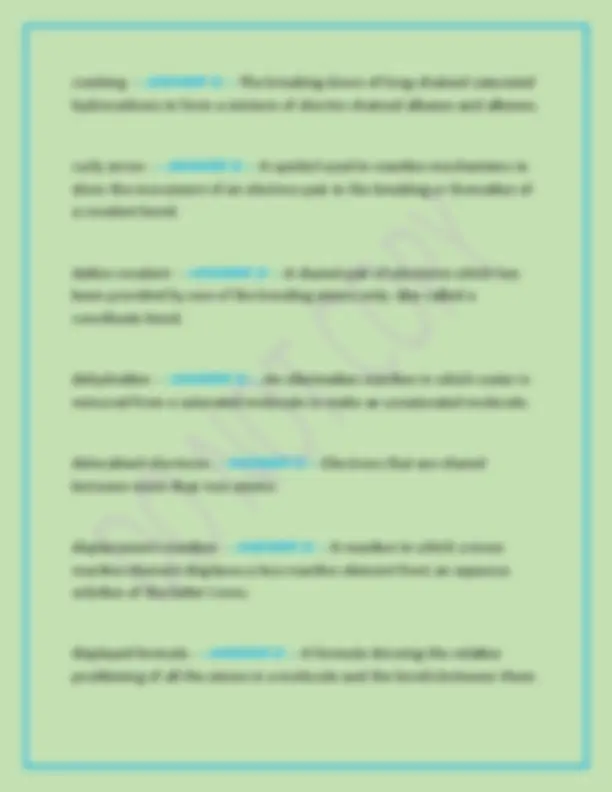
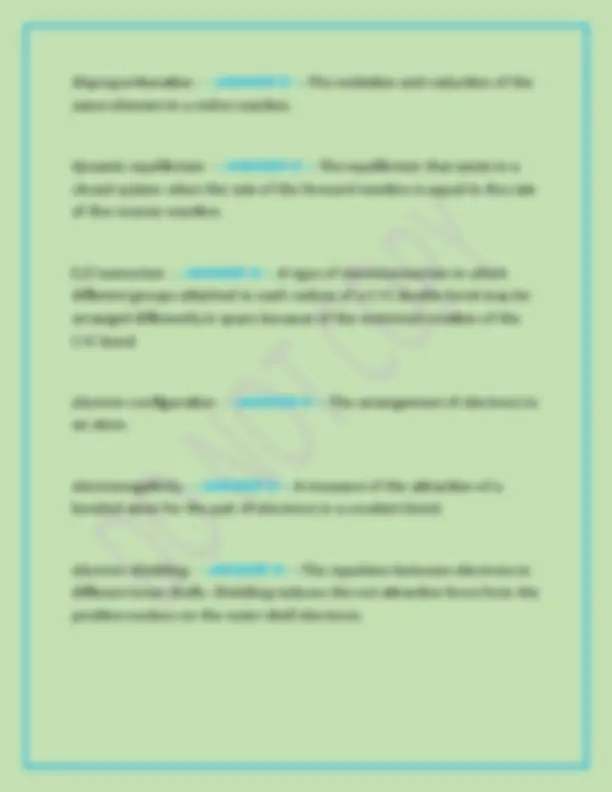
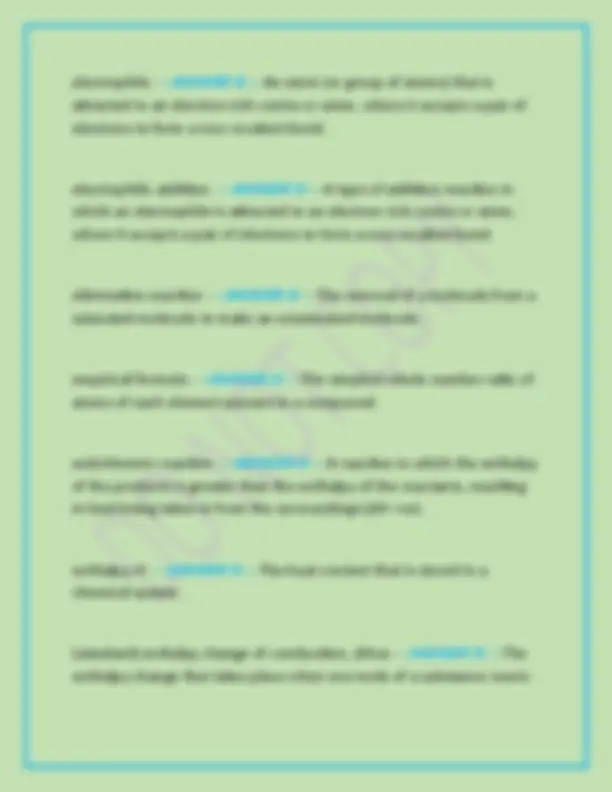
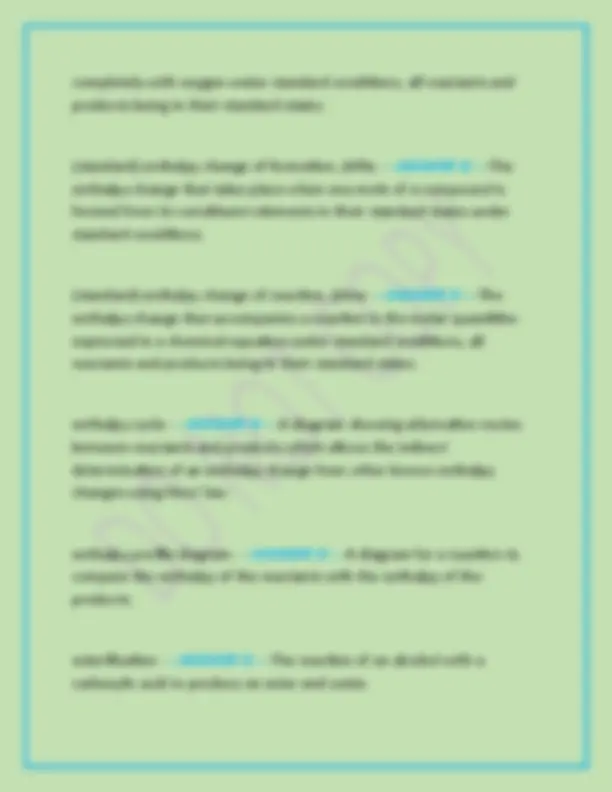
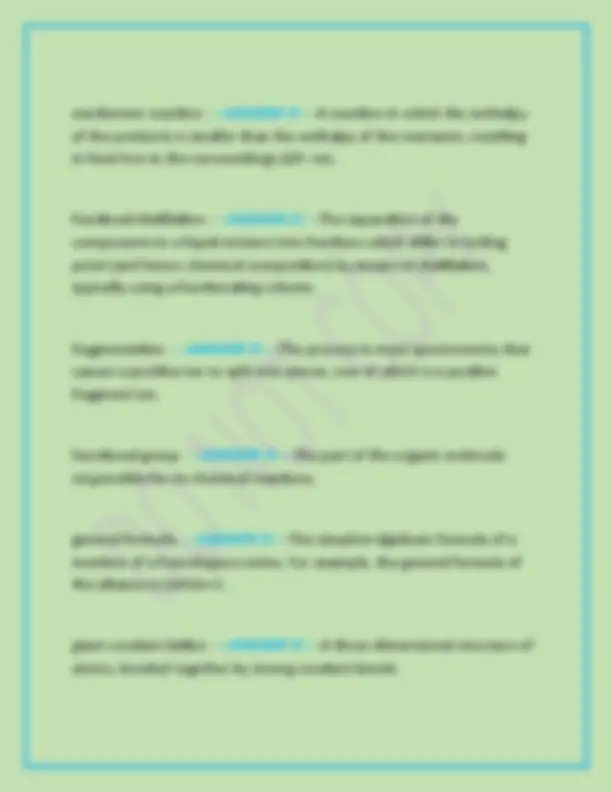
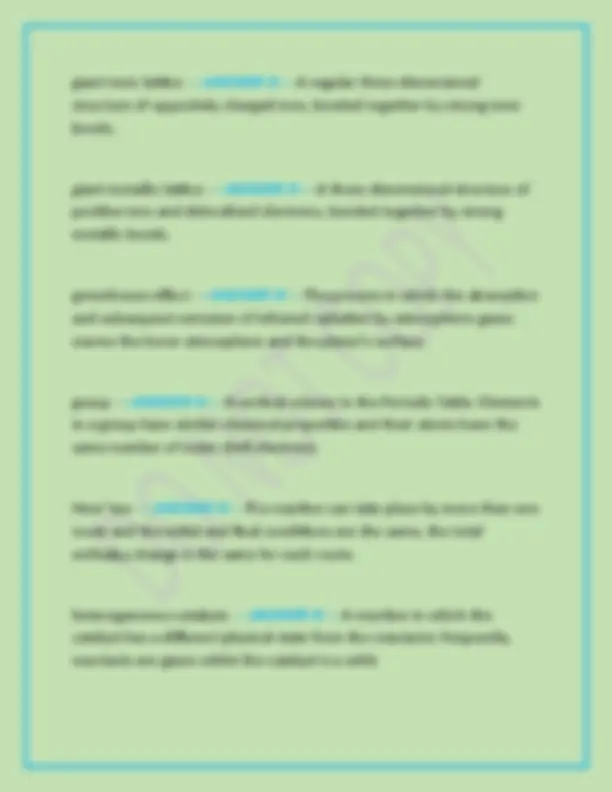
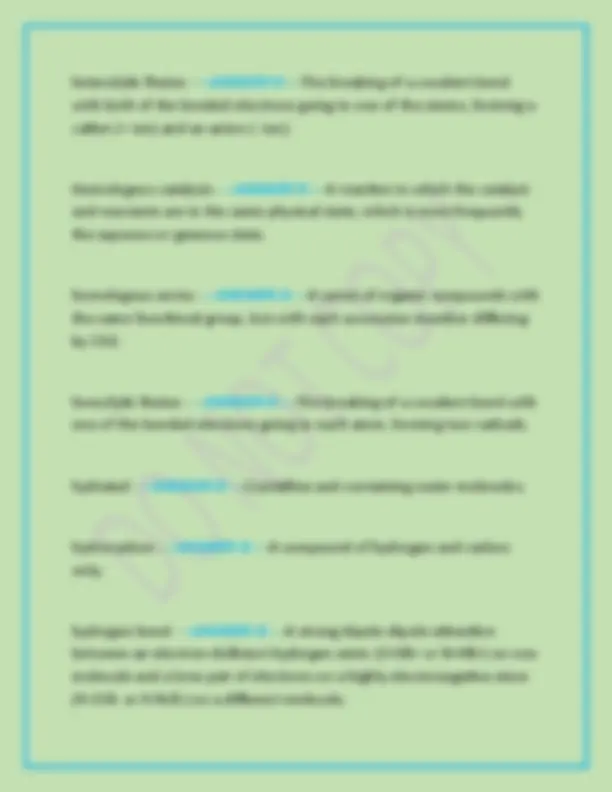
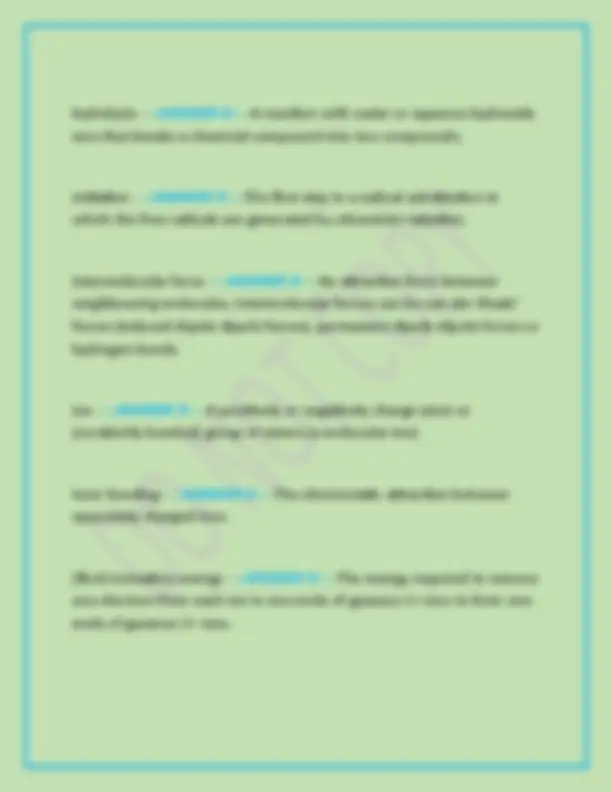
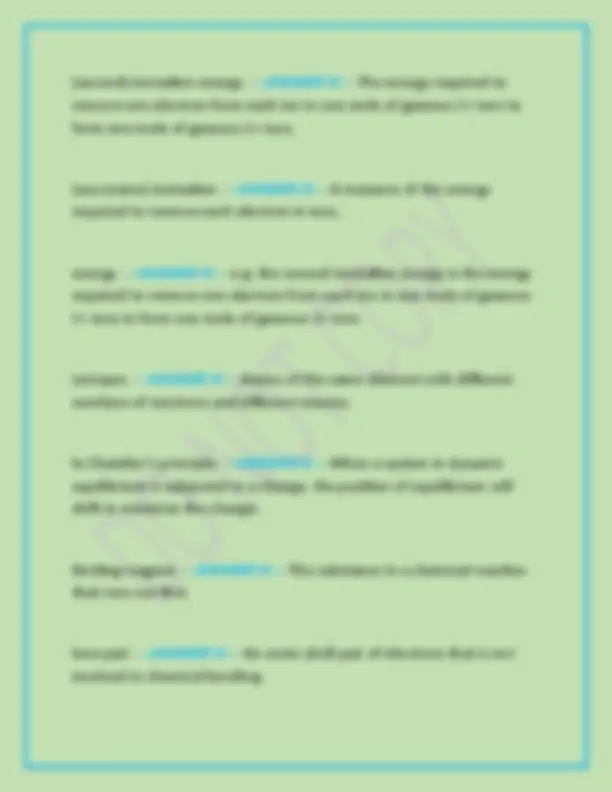
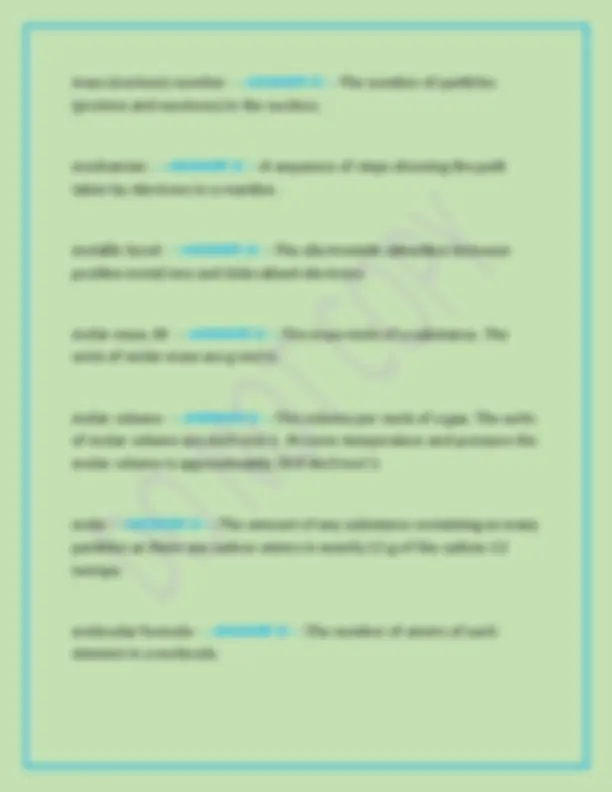
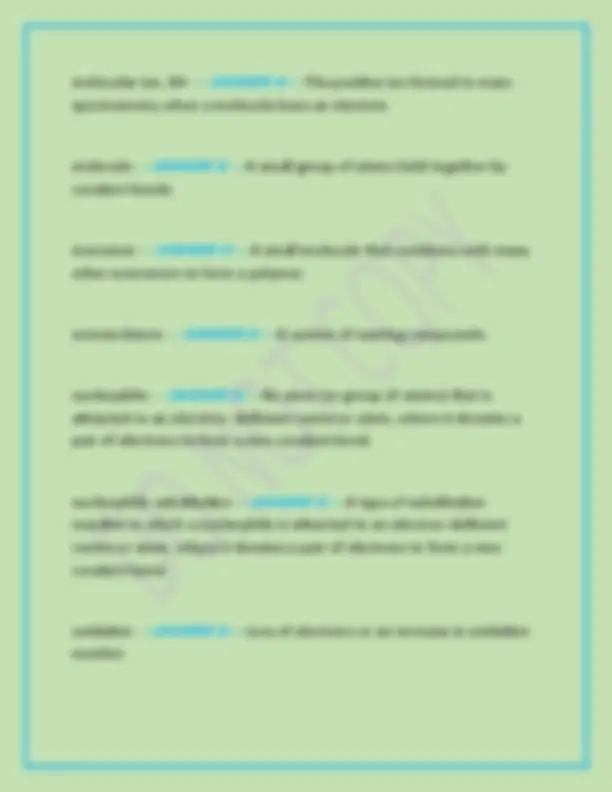
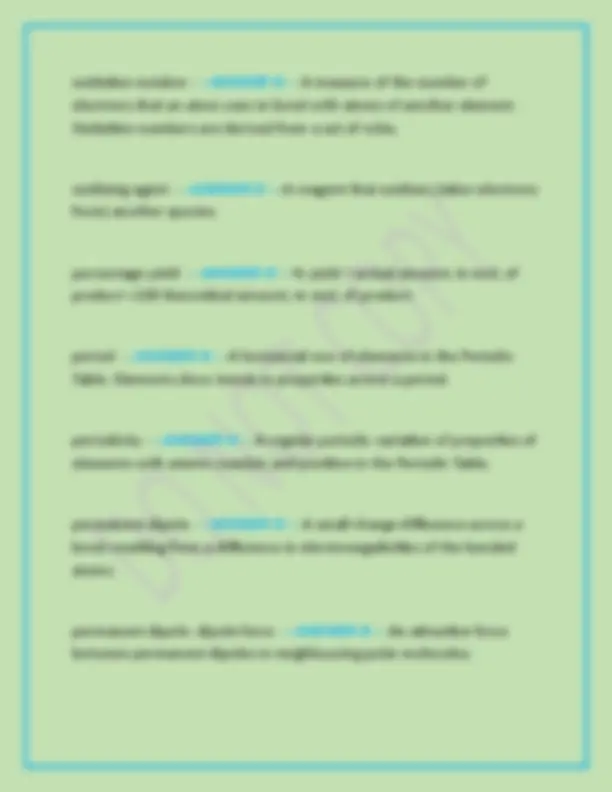
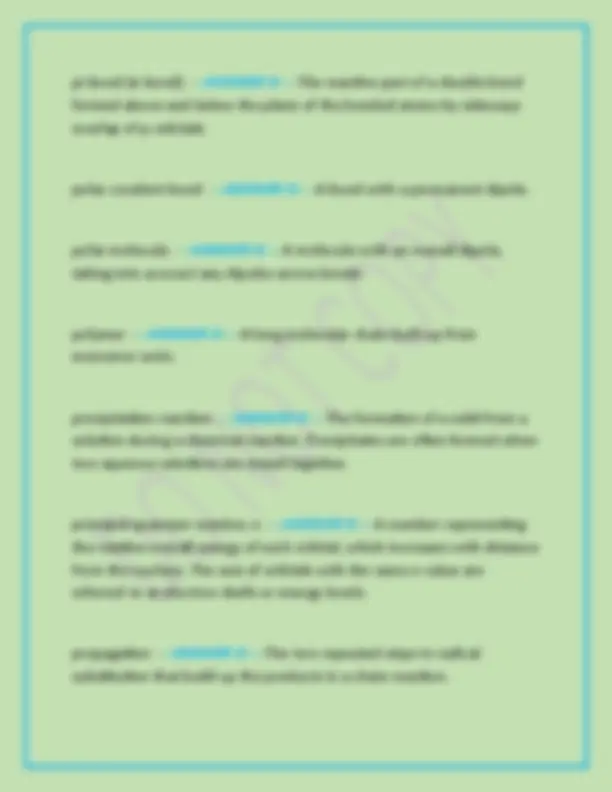

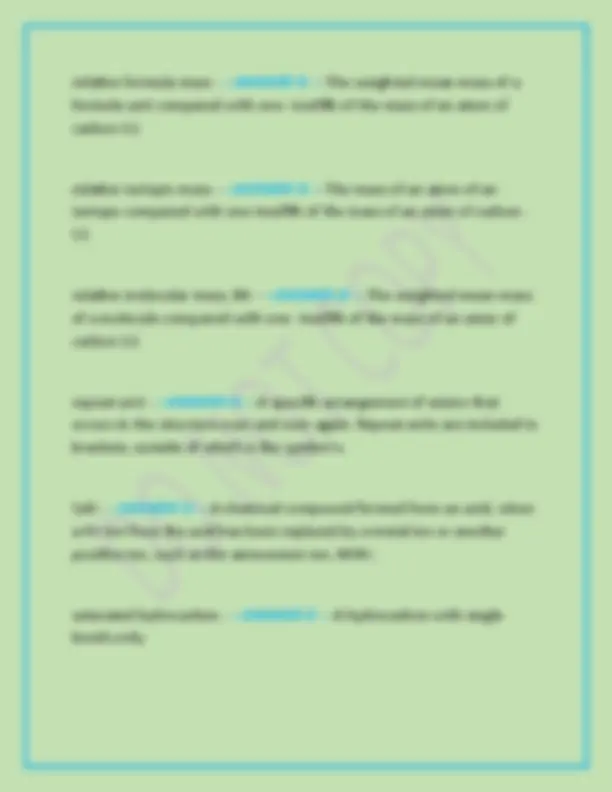
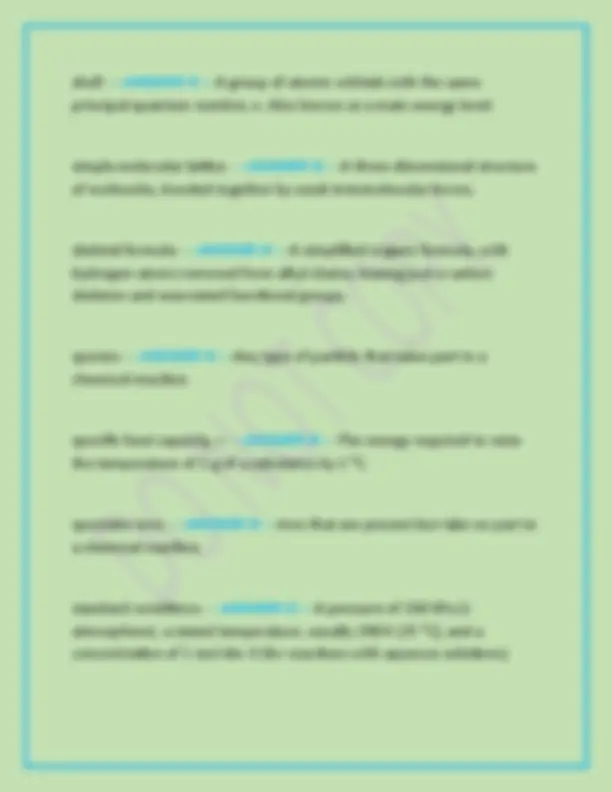
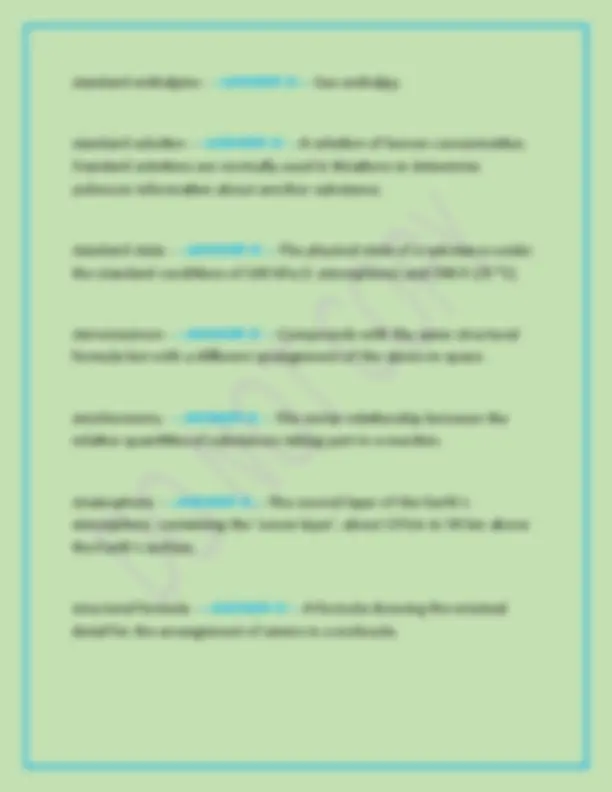
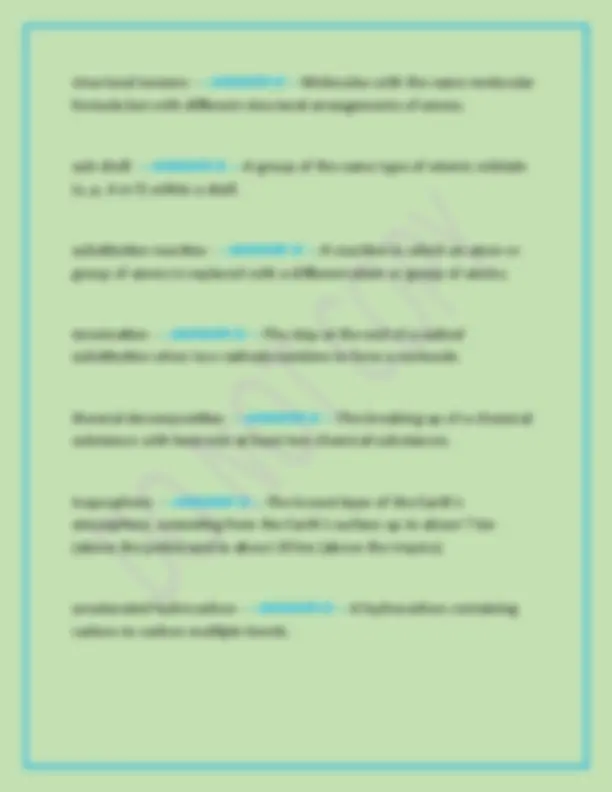

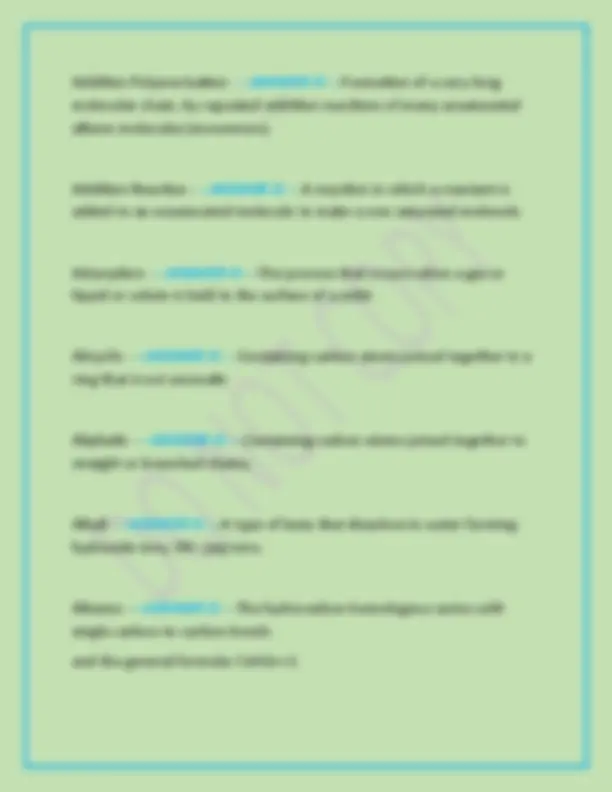
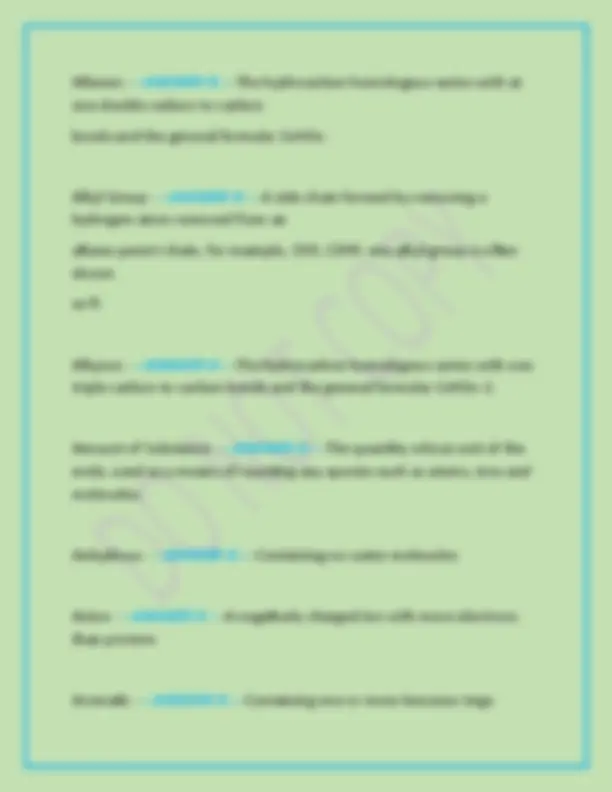
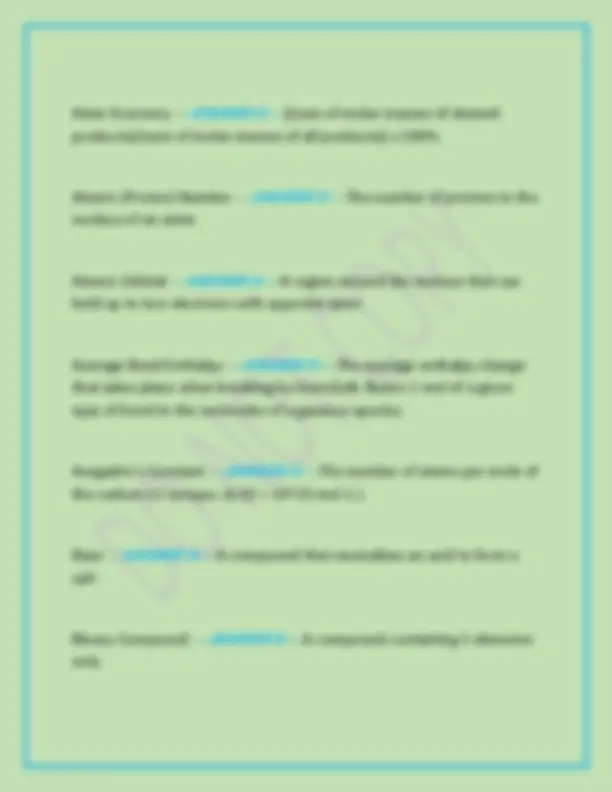

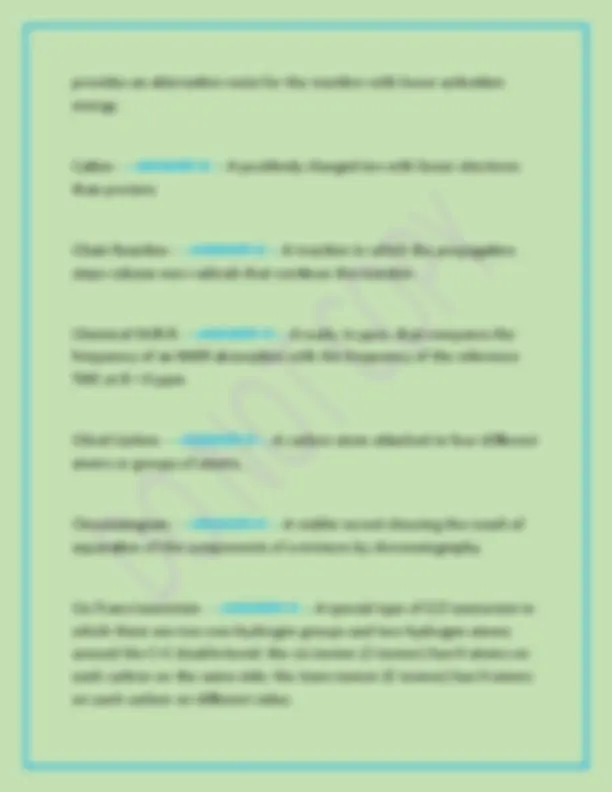
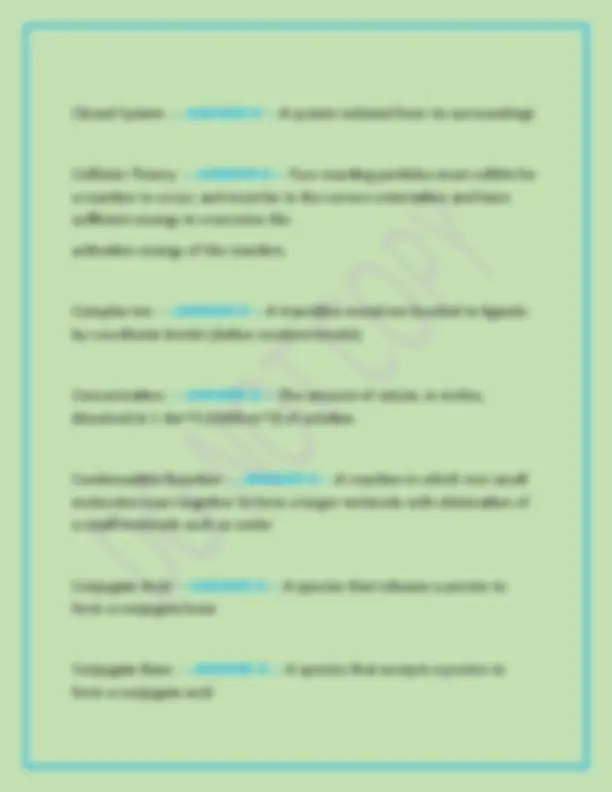

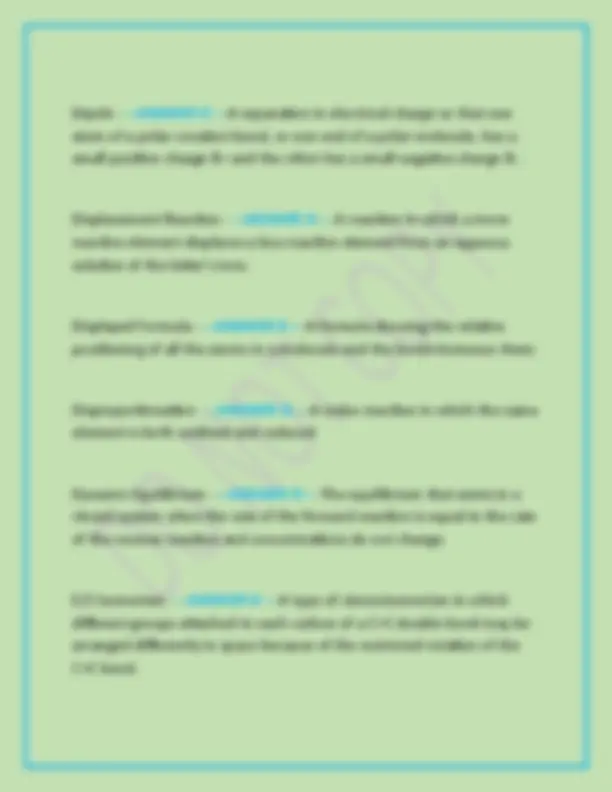


Study with the several resources on Docsity

Earn points by helping other students or get them with a premium plan


Prepare for your exams
Study with the several resources on Docsity

Earn points to download
Earn points by helping other students or get them with a premium plan
Community
Ask the community for help and clear up your study doubts
Discover the best universities in your country according to Docsity users
Free resources
Download our free guides on studying techniques, anxiety management strategies, and thesis advice from Docsity tutors
A-LEVEL OCR CHEMISTRY A PAPER 2: SYNTHESIS AND ANALYTICAL TECHNIQUES | JUNE 2025 EXAM | LATEST 2024–2025 QUESTION PAPER WITH MARK SCHEME AND DETAILED ANSWERS\ ALREADY GRADED A+
Typology: Exams
1 / 70

This page cannot be seen from the preview
Don't miss anything!































































Empirical Formula - --ANSWER IS -- - The formula that shows the simplest whole-number ratio of atoms of each element present in a compound Enantiomers - --ANSWER IS -- - Stereoisomers that are nonsuperimposable mirror images of each other; also called optical isomers End Point - --ANSWER IS -- - The point in a titration at which an indicator changes colour; the end point indicates when the reaction is just complete Endothermic reaction - --ANSWER IS -- - A reaction in which the enthalpy of the products is greater than the enthalpy of the reactants, resulting in heat being taken in from the surroundings (∆H is positive). Enthalpy H - --ANSWER IS -- - The heat content that is stored in a chemical system Enthalpy change ΔH - --ANSWER IS -- - The difference between the enthalpy of the products and the enthalpy of the reactants Enthalpy Cycle - --ANSWER IS -- - A diagram showing alternative routes between reactants and products which allows the indirect
determination of an enthalpy change from other known enthalpy changes using Hess' law. Enthalpy Profile Diagram - --ANSWER IS -- - A diagram for a reaction to compare the enthalpy of the reactants with the enthalpy of the products. Entropy - --ANSWER IS -- - The measurement used for the dispersal of energy and disorder within the chemicals making up the chemical system Equilibrium Constant Kc - --ANSWER IS -- - A measure of the position of equilibrium; the magnitude of an equilibrium constant indicates whether there are more reactants or more products in an equilibrium system. Equivalence Point - --ANSWER IS -- - The point in a titration at which the volume of one solution has reacted exactly with the volume of the second solution Esterification - --ANSWER IS -- - A reaction in which a carboxylic acid reacts with an alcohol to form an ester and water.
Fragmentation - --ANSWER IS -- - The process in mass spectrometry that causes a positive ion to split into pieces, one of which is a positive fragment ion. Free Energy Change ΔG - --ANSWER IS -- - The balance between enthalpy, entropy and temperature for a process given by ΔG = ΔH − TΔS. A process is feasible when ΔG < 0. Functional Group - --ANSWER IS -- - The part of the organic molecule responsible for its chemical reactions. General Formula - --ANSWER IS -- - The simplest algebraic formula of a member of a homologous series. For example, the general formula of the alkanes is CnH2n+ Giant Covalent Lattice - --ANSWER IS -- - A three-dimensional structure of atoms, bonded together by strong covalent bonds. Giant Ionic Lattice - --ANSWER IS -- - A three-dimensional structure of oppositely charged ions, bonded together by strong ionic bonds. Giant Metallic Lattice - --ANSWER IS -- - A three-dimensional structure of positive ions and delocalised electrons, bonded together by strong metallic bonds.
Group - --ANSWER IS -- - A vertical column in the periodic table. Elements in a group have similar chemical properties and their atoms have the same number of outer shell electrons Half-Life - --ANSWER IS -- - The time taken for the concentration of a reactant to decrease by half Hess's Law - --ANSWER IS -- - If a reaction can take place by more than one route and the initial and final conditions are the same, the total enthalpy change is the same for each route. Heterogenous Catalysis - --ANSWER IS -- - A reaction in which the catalyst has a different physical state from the reactants; frequently reactants are gases whilst the catalyst is a solid. Hetergenous Equilibrium - --ANSWER IS -- - An equilibrium in which the species making up the reactants and products have different physical states. Heterolytic Fission - --ANSWER IS -- - The breaking of a covalent bond with both of the bonded electrons going to one of the atoms, forming a cation and an anion
one molecule and a lone pair of electrons on a highly electronegative atom containing N, O or F on a different molecule. Hydrolysis - --ANSWER IS -- - A reaction with water that breaks a chemical compound into two compounds, the H and OH in a water molecule becomes incorporated into the two compounds. Induced Dipole-Dipole Interaction - --ANSWER IS -- - Attractive forces between induced dipoles in different molecules- also called London Forces Infrared Spectroscopy - --ANSWER IS -- - An instrumentation method of analysis that identifies bonds from absorption of the infrared radiation of different wavelengths Initial Rate of Reaction - --ANSWER IS -- - The change in concentration of a reactant or product per unit time at the start of the reaction when t= Initiation - --ANSWER IS -- - The first stage in a radical reaction in which radicals are generated when a covalent bond is broken by homolytic fission Intermediate - --ANSWER IS -- - A species formed during a reaction that reacts further and is not present in the final products
Intermolecular force - --ANSWER IS -- - An attractive force between molecules. Intermolecular forces can be London forces, permanent dipole-dipole interactions or hydrogen bonding. Ion - --ANSWER IS -- - A positively or negatively charged atom or a (covalently bonded) group of atoms (a polyatomic ion), where the number of electrons is different from the number of protons Ionic Bonding - --ANSWER IS -- - The electrostatic attraction between oppositely charged ions Ionic Product of Water Kw - --ANSWER IS -- - The product of the ions formed in the partial dissociation of water, given by Kw = [H+ (aq)] [OH− (aq)]. Isotopes - --ANSWER IS -- - Atoms of the same element with different numbers of neutrons and different masses Lattice Enthalpy - --ANSWER IS -- - The enthalpy change that accompanies the formation of one mole of an ionic compound from its gaseous ions under standard conditions
Molar Gas Volume Vm - --ANSWER IS -- - The volume per mole of gas molecules at a stated temperature and pressure Molar Mass M - --ANSWER IS -- - The mass per mole of a substance, in units of gmol^- 1 Mole - --ANSWER IS -- - The amount of any substance containing as many elementary particles as there are carbon atoms in exactly 12 g of the carbon-12 isotope, that is, 6.02 × 1023 particles. Molecular Formula - --ANSWER IS -- - A formula that shows the number and type of atoms of each element present in a molecule Molecular Ion - --ANSWER IS -- - The positive ion formed in mass spectrometry when a molecule loses an electron. Molecule - --ANSWER IS -- - The smallest part of a covalent compound that can exist while retaining its chemical identity, consisting of 2 or more atoms covalently bonded together Monomer - --ANSWER IS -- - A small molecule that combines with many other monomers to form a polymer.
Neutralisation - --ANSWER IS -- - A chemical reaction in which an acid and a base react together to produce a salt and water Nomenclature - --ANSWER IS -- - A system of naming compounds Non-Polar - --ANSWER IS -- - No charge separation across a bond or in a molecule Nucleophile - --ANSWER IS -- - An atom (or group of atoms) that is attracted to an electron- deficient centre or atom, where it donates a pair of electrons to form a new covalent bond. Nucleophilic Substitution - --ANSWER IS -- - A reaction in which a nucleophile is attracted to an electron-deficient carbon atom, and replaces an atom or group of atoms on the carbon atom Optical Isomers - --ANSWER IS -- - Stereoisomers that are non- superimposable mirror images of each other; also called 'enantiomers' Order - --ANSWER IS -- - The power to which the concentration of a reactant is raised in the rate equation
Pauling Electronegativity Value - --ANSWER IS -- - A value assigned as a measure of the relative attraction of a bonded atom for the pair of electrons in a covalent bond Percentage Yield - --ANSWER IS -- - % yield = ((actual amount, in mol, of product)/( theoretical amount, in mol, of product)) × 100. Period - --ANSWER IS -- - A horizontal row of elements in the periodic table. Elements show trend in properties across a period Periodicity - --ANSWER IS -- - A repeating trend in properties of the elements across each period of the periodic table Permanent Dipole - --ANSWER IS -- - A small charge difference that does not change across a bond, with δ+ and δ− partial changes on the bonded atoms: the result of the bonded atoms having different electrongativities. Permanent Dipole-Dipole Interaction - --ANSWER IS -- - An attractive force between permanent dipoles in neighbouring polar molecules. pH - --ANSWER IS -- - pH = −log[H+ (aq)]
Polar molecule - --ANSWER IS -- - δ+ and δ− charges at different ends of the molecule. Has an overall dipole, having taken into account any dipoles across bonds and the shape of the molecule Polar Covalent Bond - --ANSWER IS -- - A bond with a permanent dipole, having δ+ and δ− partial changes on the bonded atoms Polyatomic Ion - --ANSWER IS -- - An ion composed of more than one atom Polymer - --ANSWER IS -- - A large molecule formed from many thousands of repeat units of smaller molecules known as monomers Position of Equilibrium - --ANSWER IS -- - The relative quantities of reactants and products, indicating the extent of a reversible reaction at equilibrium Precipitation Reaction - --ANSWER IS -- - The formation of a solid from a solution during a chemical reaction. Precipitates are often formed when two aqueous solutions are mixed together. Primary - --ANSWER IS -- - On a carbon atom at the end of a chain
Rate of Reaction - --ANSWER IS -- - the change in concentration of a reactant or product in a given time Rate-Determining Step - --ANSWER IS -- - The slowest step in the reaction mechanism of a multi-step reaction Reaction Mechanism - --ANSWER IS -- - The sequence of bond breaking and bond-forming steps that shows the path taken by electrons during a reaction. Redox Reaction - --ANSWER IS -- - A reaction involving reduction and oxidation Reducing Agent - --ANSWER IS -- - A reagent that reduces (adds electrons to) another species Reduction - --ANSWER IS -- - Gain of electrons or a decrease in oxidation number Reflux - --ANSWER IS -- - The continual boiling and condensing of a reaction mixture back to the original container to ensure that the reaction takes place without the contents of the flask boiling dry.
Relative Atomic Mass Ar - --ANSWER IS -- - The weighted mean mass of an atom of an element compared with 1/12 of the mass of an atom of carbon- 12 Relative Formula Mass - --ANSWER IS -- - The weighted mean mass of the formula unit of a compound compared with 1/12 of the mass of an atom of carbon-12. Relative Isotopic Mass - --ANSWER IS -- - The mass of an atom of an isotope compared with 1/12 of the mass of an atom of carbon- 12 Relative Molecular Mass Mr - --ANSWER IS -- - The weighted mean mass of a molecule of a compound compared with 1/12 of the mass of an atom of carbon- 12 Repeat Unit - --ANSWER IS -- - A specific arrangement of atoms that occurs in the structure over and over again. Repeat units are included in brackets, outside of which is the symbol n. Retention Time - --ANSWER IS -- - In gas chromatography. The time for a component to pass from the column inlet to the detector Reversible Reaction - --ANSWER IS -- - A reaction that takes place in both forward and reverse directions